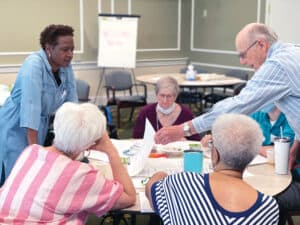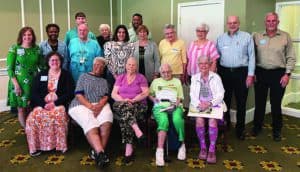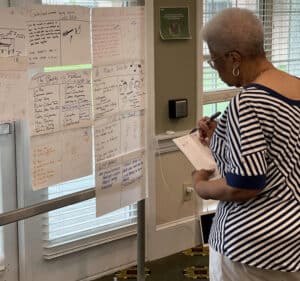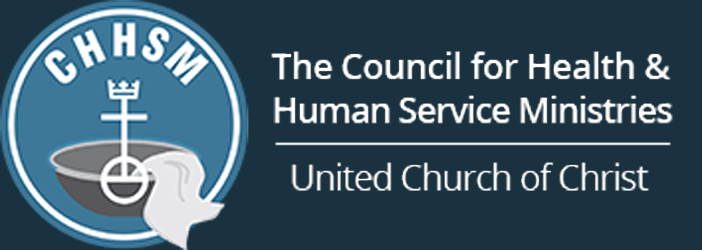Human-Centered Design Generates Community Improvements

By Catherine West
This article is reprinted with permission from the Fall 2022 issue of United Church Homes’ Spirit Magazine.
Among the creative ideas introduced to United Church Homes by Michael Hughes — who joined UCH’s leadership team late 2021 — is the use of human-centered design. This approach to problem-solving recognizes the perspectives and experiences of internal and external customers in all steps of the process.
Functioning as senior executive vice president and chief transformation and innovation officer, Hughes is a creative guy. But he’s so much more than that given his 17 years of experience in managed care, health innovation and expertise in developing programs and partnerships that improve care management. He’s tasked with leading UCH’s digital product and service line development, managing major change processes and driving important partnerships that advance innovation and growth.
Soon after joining the UCH team, Hughes was eager to pilot a program to demonstrate the benefits of human-centered design. Having previously worked in various positions at AARP, he formed a partnership with its Innovation Labs to host a two-day idea session with residents at UCH’s The Parkvue Community. Using a modified version of AARP’s Baldridge Award winning human-centered design training program, 15 residents were engaged in an Idea-A-Thon to identify ways to enhance resident life in the life plan community.

“Creativity and curiosity never retire,” Hughes said. “Who better to involve in the process than residents from The Parkvue Community and what better way to measure effectiveness of human-centered design? Ultimately, I envision the process being used to address three key dynamics shaping UCH’s future: the desire for more personalized offerings of support and services; the desire to age at home and associated need for services; and access to continuous and unlimited connections through the digital world.”
The Idea-A-Thon invited residents to engage in fun activities while creating ideas to enhance resident life at Parkvue Community. Participants were encouraged to think outside the box and flex their creative muscles in identifying the most promising ways to use $1,000 to benefit the community’s residents.
More than 20 ideas were generated and assigned an action — from low hanging fruit (achievable without funding) to being incorporated into larger ideas. This review and discussion provided deep resident insights including the desire to sustain enjoyment and vibrancy for as long as possible, the desire for new and purposeful experiences, and fear about cognitive decline and loss of functionality and the desire to strengthen and improve both.
Residents categorized ideas into three themes that were further developed into vision statements:
Musical Joy — Create a program that brings and spreads joy through the power of music. In collaboration with the resident committee and a music director, residents would be able to participate in a themed musical experience once a month. The $1,000 funding request included a karaoke machine and lap drums for group activities that can include all residents.
Bees, Butterflies and Humans — Enhance and create an elevated enchanting outdoor picnic garden experience, acting as a catalyst for gathering as a community and being able to be with family and friends in your own bubble. The $1,000 funding request was for new plantings and lighting to make outdoor space more biodiverse and enticing for use.
Physical Wellness, Always — Create a physical fitness program to make it easier to build strength and balance enabling us to sustain life vibrancy and fun for as long as possible. The $1,000 funding request was for exercise programs to support strength and balance.

Consultant and former Disney Innovation Catalyst Sura Al-Naimi, who helped construct the Idea-A-Thon format and approach working hand-in-hand with AARP, assisted residents working in teams to further develop the ideas and their pitches to UCH leaders for the $1,000.
“The process was strengthened through the participation of a diverse group of residents,” Hughes said. “The structure of the workshops allowed all ideas to be heard, for non-judgmental feedback, and group visioning that recognized common intent behind individual ideas.”
“There’s a misperception that senior living is one-size-fits-all,” he continued. “That line of thinking doesn’t fit with what UCH is striving to achieve. Residents add to the mosaic of life and make significant contributions to the sense of community UCH strives to achieve.”
The process isn’t over yet. It’s important to track progress, fine-tune ideas, and implement those not funded through the process. How many will ultimately be implemented?
Hughes sees additional opportunities for use of human-centered design to problem-solve with both residents and staff and can be incorporated as part of UCH’s relentless pursuit of improvement at all levels of the organization.
“This process will help ensure that UCH programs and other offerings are based on residents’ needs and wants,” Hughes said. “What was most exciting about Parkvue’s Idea-A-Thon was how engaged residents were in the process. The number of ideas generated, the reasoning behind the ideas, the energy and engagement of the group, and the dynamics of collaboration were all similar to that of individuals trained in corporate and non-profit organizations.”
Join Our Mailing LIst
Follow on Facebook
Iredell Adult Day Services Hosts Ribbon-Cutting to Celebrate Adult Day Health Certification - CHHSM
www.chhsm.org
Iredell Adult Day Services (IADS) in Newton, N.C. — a nonprofit organization dedicated to caring for older adults, vulnerable groups, and their families, and part of EveryAge — hosted a ribbon cut...